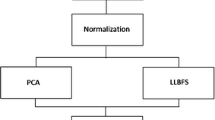Abstract
This paper seeks to detect Parkinson’s disease among healthy cases, several neurological diseases, in particular those which are very similar, that is to say representing a parkinsonian syndrome such as multi system atrophy. Early detection based on the phonatory symptoms will offer a possibility to the treatments proposed by the doctors to act effectively on the patient hence the interest of our project. We used several algorithms such as MFCC, PLP and RASTA PLP in addition to our new technique called Real Cepstral Discrete Cosine Transform with an SVM classifier with its different kernels to guarantee a better detection.
Similar content being viewed by others
References
Benba, A., Jilbab, A., & Hammouch, A. (2015). Detecting patients with Parkinson’s disease using Mel frequency cepstral coefficients and support vector machines. International Journal on Electrical Engineering and Informatics, 7(2), 297.
Benba, A., Jilbab, A., & Hammouch, A. (2016a). Discriminating between patients with Parkinson’s and neurological diseases using cepstral analysis. IEEE Transactions on Neural Systems and Rehabilitation Engineering, 24(10), 1100–1108.
Benba, A., Jilbab, A., & Hammouch, A. (2016b). Analysis of multiple types of voice recordings in cepstral domain using MFCC for discriminating between patients with Parkinson’s disease and healthy people. International Journal of Speech Technology, 19(3), 449–456.
Benba, A., Jilbab, A., & Hammouch, A. (2016c). Voice assessments for detecting patients with Parkinson’s diseases using PCA and NPCA. International Journal of Speech Technology, 19(4), 743–754.
Benba, A., Jilbab, A., & Hammouch, A. (2017a). Detecting multiple system atrophy, Parkinson and other neurological disorders using voice analysis. International Journal of Speech Technology, 20(2), 281–288.
Benba, A., Jilbab, A., & Hammouch, A. (2017b). Voice assessments for detecting patients with neurological diseases using PCA and NPCA. International Journal of Speech Technology, 20(3), 673–683.
de la Fuente-Fernández, R. (2012). Role of DaTSCAN and clinical diagnosis in Parkinson disease. Neurology, 78(10), 696–701.
De Lau, L. M. L., & Breteler, M. M. B. (2016). Epidemiology of Parkinson’s disease. Lancet Neurology, 5, 525–535.
Fenelon, G. (1997). Diagnostic et évolution (sous traitement) de la maladie de Parkinson: Mouvements anormaux. La Revue du praticien, 47(10), 1062–1067.
Gibb, W. R., & Lees, A. J. (1988). The relevance of the Lewy body to the pathogenesis of idiopathic Parkinson’s disease. Journal of Neurology, Neurosurgery & Psychiatry, 51(6), 745–752.
Hermansky, H. (1990). Perceptual linear predictive (PLP) analysis of speech. The Journal of the Acoustical Society of America, 87(4), 1738–52.
Hermansky, H., Morgan, N., Bayya, A., & Kohn, P. (1992). RASTA-PLP speech analysis technique. In: ICASSP-92. 1992 IEEE International Conference on Acoustics, Speech, and Signal Processing, 1992, 1992 Mar 23 (Vol. 1, pp. 121–124). IEEE.
Khellat Kihel, B. (2012). La Reconnaissance Automatique de la Maladie de Parkinson (Doctoral dissertation, usto).
Little, M. A., McSharry, P. E., Hunter, E. J., Spielman, J., & Ramig, L. O. (2009). Suitability of dysphonia measurements for telemonitoring of Parkinson’s disease. IEEE Transactions on Biomedical Engineering, 56(4), 1015–1022.
Little, M. A., McSharry, P. E., Roberts, S. J., Costello, D. A., & Moroz, I. M. (2007). Exploiting nonlinear recurrence and fractal scaling properties for voice disorder detection. BioMedical Engineering OnLine, 6(1), 23.
Makhoul, J., & Cosell, L. (1976). LPCW: An LPC vocoder with linear predictive spectral warping. In: IEEE International Conference on ICASSP’76, Acoustics, Speech, and Signal Processing, 1976 Apr (Vol. 1, pp. 466–469). IEEE.
Poupon, F. (1999). "Parcellisation" systématique du cerveau en volumes d'intérêt: Le cas des structures profondes (Doctoral dissertation, Lyon, INSA).
Sakar, B. E., Isenkul, M. E., Sakar, C. O., Sertbas, A., Gurgen, F., Delil, S., Apaydin, H., & Kursun, O. (2013). Collection and analysis of a Parkinson speech dataset with multiple types of sound recordings. IEEE Journal of Biomedical and Health Informatics, 17(4), 828–834.
Selkoe, D. J., & Lansbury, P. J., Jr. (1999). basic Neurochemistry: Molecular, cellular and medical aspects (6th ed.). American Society for Neurochemistry.
Skipper, L., Wilkes, K., Toft, M., Baker, M., Lincoln, S., Hulihan, M., Ross, O. A., Hutton, M., Aasly, J., & Farrer, M. (2004). Linkage disequilibrium and association of MAPT H1 in Parkinson disease. The American Journal of Human Genetics, 75(4), 669–677.
Soikkeli, R., Partanen, J., Soininen, H., Pääkkönen, A., & Riekkinen, P. (1991). Slowing of EEG in Parkinson’s disease. Electroencephalography and Clinical Neurophysiology, 79(3), 159–165.
Van Den Eeden, S. K., Tanner, C. M., Bernstein, A. L., Fross, R. D., Leimpeter, A., Bloch, D. A., & Nelson, L. M. (2003). Incidence of Parkinson’s disease: Variation by age, gender, and race/ethnicity. American Journal of Epidemiology, 157(11), 1015–1022.
Young, S., Evermann, G., Gales, M., Hain, T., Kershaw, D., Liu, X., Moore, G., Odell, J., Ollason, D., Povey, D., & Valtchev, V. (2002). The HTK book (Vol. 3, p. 175). Cambridge University Engineering Department.
Author information
Authors and Affiliations
Corresponding author
Additional information
Publisher's Note
Springer Nature remains neutral with regard to jurisdictional claims in published maps and institutional affiliations.
Rights and permissions
About this article
Cite this article
Benba, A., Laaqira, I., Jilbab, A. et al. Using novel method: Real Cepstral Discrete Cosine Transform, for detecting Parkinson from multiple system atrophy, other neurological diseases and healthy cases using voice analysis. Int J Speech Technol 25, 163–172 (2022). https://doi.org/10.1007/s10772-021-09896-y
Received:
Accepted:
Published:
Issue Date:
DOI: https://doi.org/10.1007/s10772-021-09896-y




